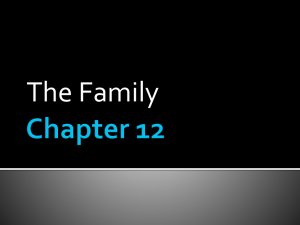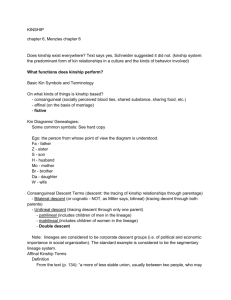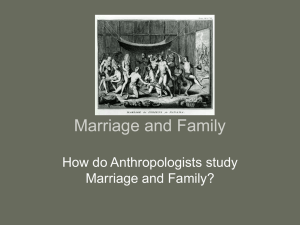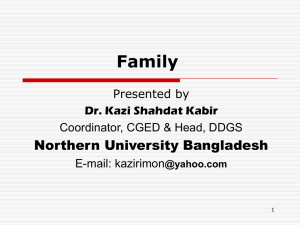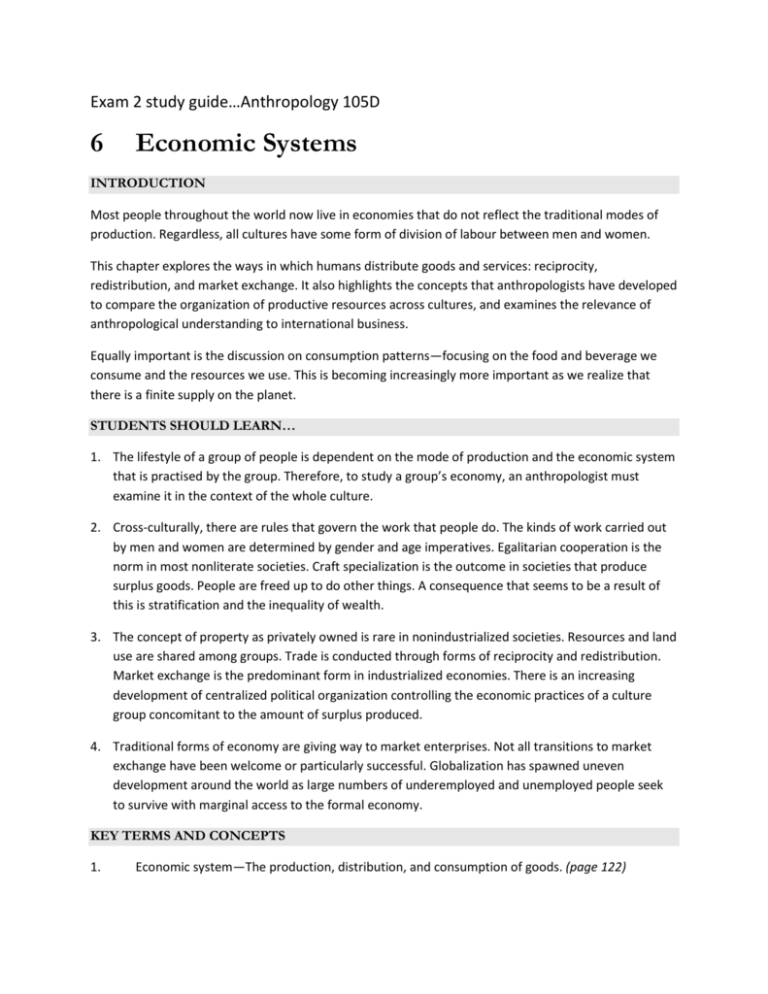
Exam 2 study guide…Anthropology 105D
6
Economic Systems
INTRODUCTION
Most people throughout the world now live in economies that do not reflect the traditional modes of
production. Regardless, all cultures have some form of division of labour between men and women.
This chapter explores the ways in which humans distribute goods and services: reciprocity,
redistribution, and market exchange. It also highlights the concepts that anthropologists have developed
to compare the organization of productive resources across cultures, and examines the relevance of
anthropological understanding to international business.
Equally important is the discussion on consumption patterns—focusing on the food and beverage we
consume and the resources we use. This is becoming increasingly more important as we realize that
there is a finite supply on the planet.
STUDENTS SHOULD LEARN…
1. The lifestyle of a group of people is dependent on the mode of production and the economic system
that is practised by the group. Therefore, to study a group’s economy, an anthropologist must
examine it in the context of the whole culture.
2. Cross-culturally, there are rules that govern the work that people do. The kinds of work carried out
by men and women are determined by gender and age imperatives. Egalitarian cooperation is the
norm in most nonliterate societies. Craft specialization is the outcome in societies that produce
surplus goods. People are freed up to do other things. A consequence that seems to be a result of
this is stratification and the inequality of wealth.
3. The concept of property as privately owned is rare in nonindustrialized societies. Resources and land
use are shared among groups. Trade is conducted through forms of reciprocity and redistribution.
Market exchange is the predominant form in industrialized economies. There is an increasing
development of centralized political organization controlling the economic practices of a culture
group concomitant to the amount of surplus produced.
4. Traditional forms of economy are giving way to market enterprises. Not all transitions to market
exchange have been welcome or particularly successful. Globalization has spawned uneven
development around the world as large numbers of underemployed and unemployed people seek
to survive with marginal access to the formal economy.
KEY TERMS AND CONCEPTS
1.
Economic system—The production, distribution, and consumption of goods. (page 122)
2. Technology—Tools and other material equipment, together with the knowledge of how to make and
use them. (page 130)
3. Marine transhumance—Seasonal migration of people from one marine resource to the next. (page
131)
4. Reciprocity—The exchange of goods and services of approximately equal value between two
parties. (page 131)
5. Generalized reciprocity—A mode of exchange in which the value of the gift is not calculated, nor is
the time of repayment specified. (page 132)
6. Balanced reciprocity—A mode of exchange whereby the giving and the receiving are specific in
terms of the value of the goods and the time of their delivery. (page 132)
7. Negative reciprocity—A form of exchange whereby the giver tries to get the better of the exchange.
(page 132)
8. Silent trade—A form of barter with no verbal communication. (page 134)
9. Redistribution—A form of exchange in which goods flow into a central place where they are sorted,
counted, and reallocated. (page 135)
10. Levelling mechanism—A societal obligation compelling people to redistribute goods so that no one
accumulates more wealth than anyone else. (page 135)
11. Conspicuous consumption—A term Thorstein Veblen coined to describe the display of wealth for
social prestige. (page 135)
12. Potlatch—A special celebration in which the people of a community come together to enjoy
elaborate feasts, ceremonial dancing, and gift giving. The potlatch serves as an opportunity for
chiefs to enhance their status with public displays of generosity. (page 135)
13. Market exchange—The buying and selling of goods and services, with prices set by the powers of
supply and demand. (page 137)
14. Money—Anything used to make payments for goods or labour as well as to measure their value;
may be special-purpose or multipurpose. (page 138)
15.
Consumption—The ingestion of food and the exploitation of available resources. (page 13)
16. Globalization—The process of opening up world markets using modern technology. (page 141)
7
Sex and Marriage
INTRODUCTION
Marriage is regarded as a cultural construct and defined from an inclusive, global perspective,
particularly with respect to social structure and the environment. The many different forms existing
around the world are discussed and linked to underlying economic and legal practices, particularly with
respect to notions of property and inheritance.
Nontraditional forms of marriage are becoming increasingly common. This chapter explores such diverse
forms as ghost marriages, women unions, and arranged marriages.
Human sexuality has only become a focus for anthropologists in the last few years, largely due to the
sensitive nature of the topic and because the topic was a professional taboo until recently. The incest
taboo is explored, and a cross-cultural overview of homosexuality is provided.
STUDENTS SHOULD LEARN…
1. There are a variety of marriage patterns around the world; the most common form is monogamy. In
all instances, marriage establishes sexual access between partners. Officially recognized marriage
unions are connected to social, legal, and economic forces in the culture.
2. Anthropologists must weigh in on such practices as “honour killing” and “female circumcision,”
which violate what we consider to be universal human rights and our own Canadian values. Such
practices have been carried out right here in our own country and must not be tolerated.
3. The study of human sexuality by anthropologists is a relatively recent phenomenon. Anthropologists
document the vast cultural variations in perception of human sexuality and the meanings associated
with them.
4. There is a near universal incest taboo that forbids sexual relations between parents and their
children. Most cultures forbid relations between siblings, too.
KEY TERMS AND CONCEPTS
1. Homosexuality—Sexual attraction to (or sexual relations with) persons of the same sex. (page 151)
2. Sexual orientation—The biological and psychological makeup of an individual. (page 151)
3. Sexual identity—The identity a person takes based on his or her sexual preference. (page 151)
4. Marriage—The social institution under which a man and woman, or partners of the same gender,
live as husband and wife by legal commitments and establish a claim to sexual access to each
another. (page 154)
5. Affinal kin—Relatives by marriage. (page 155)
6. Conjugal bond—The bond between a man and a woman who are married. (page 155)
7. Consanguineal kin—Relatives by birth—that is, “blood” relatives. (page 155)
8. Incest taboo—The prohibition of sexual relations between specified individuals, usually parent–child
and intersibling relations at a minimum. (page 155)
9. Female circumcision—The removal of all or part of a female’s genitalia for religious, traditional, or
socioeconomic reasons. (page 157)
10. Instinct explanation—Sometimes known as “familiarity breeds contempt,” this explanation suggests
that long-term association with family members discourages sexual interest. (page 157)
11. Psychoanalytical explanation—Incest taboos are an attempt by offspring to repress their sexual
feelings toward their parents of the opposite gender. (page 157)
12. Genetic explanation—Inbreeding is forbidden because cultural groups recognize the potential for
impaired offspring. (page 157)
13. Social explanation—Sometimes known as the “peace in the family” theory, this explanation suggests
that competition over mates would interfere with normal family functions, such as acquiring
adequate food resources. (page 158)
14. Endogamy—Marriage within a particular group or category of individuals. (page 158)
15. Exogamy—Marriage outside the group. (page 159
16. Cooperation explanation—Forcing people outside their familial unit. (page 159)
17. Monogamy—Marriage in which an individual has one spouse. (page 161)
18. Polygyny—The marriage custom in which a man has two or more wives simultaneously; a form of
polygamy. (page 161)
19. Polyandry—The marriage of one woman to two or more men simultaneously. (page 163)
20. Group marriage—Marriage in which several men and women have sexual access to one another.
(page 164)
21. Levirate—The marriage custom whereby a widow marries a brother of her dead husband. (page
164)
22. Sororate—The marriage custom whereby a widower marries his dead wife’s sister. (page 164)
23. Serial monogamy—A marriage form in which a man or a woman marries or lives with a series of
partners in succession. (page 164)
24. Patrilateral parallel-cousin marriage—Marriage of the children of two brothers. (page 165)
25. Matrilateral cross-cousin marriage—Marriage of a woman to her father’s sister’s son or of a man to
his mother’s brother’s daughter (her cross-cousin on the paternal side, his cross-cousin on the
maternal side). (page 167)
26. Patrilateral cross-cousin marriage—Marriage of a man to his father’s sister’s daughter. (page 167)
27. Bride-price—Compensation the groom or his family pays to the bride’s family on marriage. (page
168)
28. Bride service—A designated period after marriage when the groom works for the bride’s family.
(page 168)
29. Dowry—Payment of a woman’s inheritance at the time of her marriage, either to her or to her
husband. (page 168)
8
Family and Household
INTRODUCTION
Living in a social group is a basic human need. Families are the core social groups for couples with and
without children and for single parents with children. The traditional form of family in Canada is the
nuclear family. There are many other forms of family in the world. Who then nurtures the children is a
factor of social, historical, and ecological circumstances.
Household refers to the residential unit and all the members who live there. In most cases, it is the
family that lives in a household. Problems may arise from isolation from kin, juggling work and
parenting, and the general stresses of trying to provide economically for the household members.
STUDENTS SHOULD LEARN…
1. The Western assumption that all households are built around conjugal relationships is ethnocentric.
2. There are various problems engendered by different kinds of living arrangements. Different family
patterns produce different internal tensions.
3. The variations in postmarital residence affect the way a household is made up.
KEY TERMS AND CONCEPTS
1. Family—A married or common law couple with or without children, or a lone parent with
dependent children. May sometimes include non-kin members. (page 174)
2. Culture-bound—The interpretation of other practices and beliefs from the standpoint of one’s own
culture. A culture-bound interpretation can be biased and unwilling to accept the validity of
alternative phenomena. (page 174)
3. Consanguine family—A family unit consisting of a woman, her dependent offspring, and the
woman’s brothers. (page 174)
4. Conjugal family—A family consisting of two or more married or common law people, including
same-sex people, with their dependent children. (page 174)
5. Nuclear family—A married or common law couple and their dependent children. (page 174)
6. Polygynous family—A family consisting of a man and his multiple wives, along with their dependent
children. (page 174)
7. Polyandrous family—A family consisting of a woman and her multiple husbands, along with their
dependent children. (page 175)
8. Household—The basic residential unit where economic production, consumption, inheritance,
childrearing, and shelter are organized and implemented; may or may not be synonymous with
family. (page 181)
9. Extended family—A collection of nuclear families, related by ties of blood, that live together in one
household. (page 183)
10. Patrilocal residence—A pattern in which a married couple lives in the locality associated with the
husband’s father’s relatives. (page 184)
11. Matrilocal residence—A pattern in which a married couple lives in the locality associated with the
wife’s relatives. (page 184)
12. Ambilocal residence—A pattern in which a married couple may choose either matrilocal or patrilocal
residence. (page 185)
13. Neolocal residence—A pattern in which a married couple establishes its household in a location
apart from either the husband’s or the wife’s relatives. (page 185)
14. Avunculocal residence—A pattern in which a married couple lives with the husband’s mother’s
brother. (page 186)
15. Sororal polygyny—A man marries several women who are sisters. (page 186)
16. Fraternal polyandry—A woman marries several men who are brothers. (page 187)
9
Kinship and Descent
INTRODUCTION
Cultures define family membership on the basis of the kinship system they use. The descent group is the
most common form of kinship structure whereby family members are traced from a common ancestor.
Most descent systems trace group membership through some variation of the male or female line.
These descent systems are inextricably connected to the degree in which women participate in
productive work in their cultures.
Descent groups function to provide aid and security to their members. They transmit religious traditions
and group solidarity by worship of a common ancestor. Descent groups determine marriageable
partners, which in turn work to forge alliances between groups.
The greater the number of people in an extended family group, the greater the organizational system
used. Canadians of European background use the Eskimo system of descent, which emphasizes the
nuclear family and combines all other relatives into a few general categories. Some descent systems,
however, are very complex and elaborate.
Anthropologists use a variety of different techniques to calculate the kinship system in a culture:
archaeological excavations, ethnographic research, and cross-cultural analyses. Currently, DNA
extraction is also being used to trace the descent of ancient individuals.
STUDENTS SHOULD LEARN…
1. The relatives who surround us strongly influence the way we think about the world, and the types of
beliefs, values, and status we hold.
2. All cultures have social rules and patterns that establish relatedness; these forms show a great deal
of variation globally.
3. Kinship systems are important to anthropologists because they are important to the people we
study.
4. Kinship, descent, and marriage are the building blocks of the social system, linking individuals and
groups together.
KEY TERMS AND CONCEPTS
1. Kinship—The people we are related to through blood (consanguineal) and marriage (affinal). (page
194)
2. Fictive kinship—Friends not biologically related but considered part of a kin group. (page 195)
3. Descent group—Any publicly recognized social entity requiring lineal descent from a particular real
or mythical ancestor for membership. (page 196)
4. Unilineal descent—Descent that establishes group membership exclusively through either the
mother’s or the father’s line. (page 196)
5. Matrilineal descent—Descent traced exclusively through one’s mother’s grandmother’s line, etc., to
establish group membership. (page 196)
6. Patrilineal descent—Descent traced exclusively through one’s father’s grandfather’s line, etc., to
establish group membership. (page 196)
7. Double descent—A system tracing descent matrilineally for some purposes and patrilineally for
others. (page 201)
8. Ambilineal descent—Descent in which the individual may affiliate with either the mother’s or the
father’s descent group. (page 202)
9. Lineage—A corporate descent group whose members trace their genealogical links to a common
ancestor. (page 202)
10. Fission—The splitting of a descent group into two or more new descent groups. (page 203)
11. Clan—A noncorporate descent group whose members claim descent from a common ancestor
without actually knowing the genealogical links to that ancestor. (page 203)
12. Totemism—The belief that people are related to particular animals, plants, or natural objects by
virtue of descent from common ancestral spirits. (page 203)
13. Moiety—Each group that results from a division of a society into two halves on the basis of descent.
(page 204)
14. Kindred—A group of consanguineal kin linked by their relationship to one living individual; includes
both maternal and paternal kin. (page 204)
15. Eskimo system—A system of kinship terminology, also called the lineal system, that emphasizes the
nuclear family by specifically distinguishing mother, father, brother, and sister, while lumping
together all other relatives into broad categories such as uncle, aunt, and cousin. (page 209)
16. Hawaiian system—Kinship reckoning in which all relatives of the same sex and generation are
referred to by the same term. (page 209)
17. Iroquois system—Kinship terminology wherein a father and father’s brother are given a single term,
as are a mother and mother’s sister, but a father’s sister and mother’s brother are given separate
terms. Parallel cousins are classified with brothers and sisters, while cross-cousins are classified
separately but (unlike in Crow and Omaha kinship) are not equated with relatives of some other
generation. (page 210)
18. Crow system—Kinship classification usually associated with matrilineal descent in which a father’s
sister and father’s sister’s daughter are called by the same term, a mother and mother’s sister are
merged under another, and a father and father’s brother are given a third. Parallel cousins are
equated with brothers and sisters. (page 211)
19. Omaha system—The patrilineal equivalent of the Crow system; the mother’s patrilineal kin are
equated across generations. (page 212)
20. Sudanese or descriptive system—The system of kinship terminology whereby a father, father’s
brother, and mother’s brother are distinguished from one another, as are a mother, mother’s sister,
and father’s sister; cross and parallel cousins are distinguished from one another as well as from
siblings. (page 212)
Essay Questions...
1. Compare and contrast the different ideas about the nature and control of land that exists among
food foragers, horticulturalists, pastoralists, intensive agriculturalists, and industrialists.
2. What are the three types of sexual division of labor and with which types of society are they
associated?
3. List and define three types of reciprocity and give an example of each.
4. Define and explain the function of the levirate and the sororate.
5. Define polyandry and discuss reasons for its occurrence and rarity.
6.
List and define the four most common patterns of residence practiced by couples after they marry.
7. Many North American feminists are interested in the concept of matriarchy, sometimes linking or
equating it to matrilineal descent systems. Does matrilineality imply matriarchy? Use concrete
examples to discuss.
8. Describe, in words that a non-specialist could understand, one bilateral and one unilineal system of
kinship terminology.
9. Discuss the correlation between kinship terminology and the roles people take in families.
10. Define and distinguish among bride price, bride service and dowery. Give an ethnographic example
of each.


